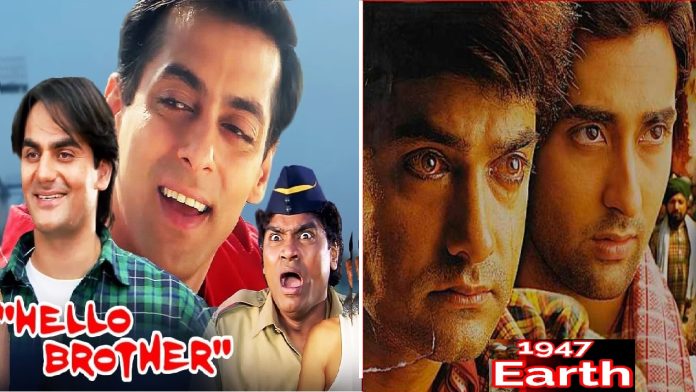HELLO BROTHER
G.S. Entertainment’s Hello Brother (UA) is a comedy film. It is the story of an innocent guy who works for a drug lord but doesn’t know that he is involved in illegal activities. A police inspector suspects that he is working for a criminal and he tries to get to the main don, using the innocent guy who turns out to be too smart for him. One day, the innocent guy comes to know of his boss’ business, and the boss, therefore, kills him. Simultaneously, the police officer is also critically injured and is in need of a heart transplant. The dead guy’s heart is transplanted into the police officer. As a result, the police officer can see and talk to the dead man. To make matters more comical, the police officer falls in love with the dead man’s girlfriend. How the dead man and the police officer first quarrel among themselves, then become friends and eliminate the drug lord forms the latter part of the drama. The dead man also helps the police officer win over his girlfriend.
Since the accent is on comedy, there’s no place for emotions at all. The drama is childish and the film sometimes looks like an assemblage of items rather than a cohesive script. The film reminds of Ghazab and Chamatkar and, therefore, has no novelty value. But, perhaps, the biggest drawback of the film are the jokes of breaking wind by the police officer’s senior, and the antics of the hero adopted by him to be one-up on his opponents. Everytime the senior police officer appears on the scene (and that’s quite often), he breaks wind and the accompanying sound effects and reactions of the others around him would leave many viewers too embarrassed. For, such things are too private to be enjoyed or laughed at in public. Further, the novelty of a character breaking wind has waned, it having been used in the recently released Hum Dil De Chuke Sanam. Of course, this very comic portion will be liked by one section of the audience (mainly youngsters) who don’t mind such stuff, but the family and class audience may find the same disgusting.
There’s no proper build-up of romance. Likewise, the climax starts pretty abruptly and it is weak, too. The short duration of the film (its running time is 2 hours and 15 minutes) is yet another drawback. Dialogues (Sohail Khan), however, are very witty and humorous.
Salman Khan, as the innocent guy, acts freely and raises a lot of laughter for his crazy antics. But it must be mentioned that Salman is repeating himself too much — he did the same crazy comedy in Pyaar Kiya To Darna Kya, in Jaanam Samjha Karo and again in Biwi No. 1. Salman’s dances are a delight to watch. Arbaaz Khan does a fairly good job as the police officer. The scene between the two Khans (where Arbaaz acts like a tapori) and the heroine is very enjoyable. Rani Mukerji dances beautifully, looks glamorous and acts quite well. Johny Lever acts with aplomb, evoking laughter almost every time he appears on the screen. Neeraj Vora’s facial expressions when he breaks wind are exceptionally natural. Shakti Kapoor is average and doesn’t get much scope. Razzak Khan is good in a couple of scenes. Sulbha Arya, Dinyar Tirandaz, Mukhtar Khan, Mahendra Verma and the others lend reasonable support.
Sohail Khan’s direction is fairly nice but his story and screenplay leave a lot to be desired. His comedy would seem weird to some, vulgar to some but also very entertaining to some. However, it will only be a section of the city audience who’d really care for the kind of mirth shown in the film. Music (Himesh Reshammiya and Sajid-Wajid) and dances (Ganesh Acharya) are, perhaps, the best things in the film. ‘Chandi ki daal par’, ‘Chunariya’, ‘Hataa saawan ki ghata’ and the title track are extremely popular numbers and their picturisations are superb, vibrant and colourful. Background score and editing (both by Yusuf Khan) are appreciable. Santosh Thundiyil’s camerawork is praiseworthy. Action scenes are alright. Production values are okay.
On the whole, Hello Brother has masala for Bombay and Maharashtra mainly. Its prospects in North India and the Eastern circuit are not too bright although it has taken a great start and has a clear field for two weeks as well as the advantage of several holidays during the two weeks. Considering its high price, it could remain a loser in several circuits.
Released on 10-9-’99 at Minerva, Eros (matinee) and 17 other cinemas of Bombay by Vimal Agarwal thru R.M. Ahuja & Co. Publicity & opening: excellent. …….Also released all over. Opening was mind-boggling in C.P. Berar and Rajasthan (1st day Jaipur about 95%). A drop in collections was noticed in Delhi-U.P. and the Eastern circuit on day 1 itself.
1947 EARTH
Deepa Mehta’s 1947 Earth (A) tells the tale of pre-Partition India. It shows the amity between Hindus, Sikhs and Muslims until the news of Partition filters in and creates mental disintegration mainly between the Hindus and the Muslims. The story, based on Bapsi Sidhwa’s celebrated novel, Cracking India, is narrated through the character of a Parsi girl. It revolves around a playful ice-candy man (Aamir Khan), a docile masseur (Rahul Khanna), the Parsi girl (Maia Sethna) and her Hindu maidservant (Nandita Das).
The first half has some light moments with Aamir Khan enlivening the goings-on with his antics, and Rahul Khanna endearing himself to the audience with his docility. The scenario changes when Aamir learns of Nandita Das’ love for Rahul. This disturbs Aamir because he, too, loves her. The tension reaches a flashpoint when a train from Gurdaspur arrives in Lahore. The train is filled with corpses of Muslims and among them are those of Aamir’s three sisters who have, like the rest, been killed by Hindus. Aamir is, therefore, filled with hatred for the Hindus. He is also agitated when the Hindu maidservant, whom he has loved, spurns him for the masseur. All this (murder of his sisters, his being spurned) causes a mental turmoil in him to such an extent that he is led to committing barbaric acts.
The film has been masterly crafted. Each and every scene and character have been perfectly etched out, thanks to an engaging screenplay. The cinematography captures the ambience of the period with great dexterity. All this technical finesse may go down well with the sophisticated audience. It would find great appreciation from the Overseas patrons. But it will not evoke the same reaction from the Indian cine goers largely due to the fact that the Partition turmoil has been relegated to the background of people’s memories and also because such a subject has been earlier dealt with in Pamela Rooks’ A Train To Pakistan. The film is terribly slow and bores the viewer, at places.
Aamir Khan is simply wonderful. He evokes a lot of laughter with his shairis in the initial reels. The drastic change of his character towards the concluding reels will, however, disappoint the audience who views him as a darling hero. Rahul Khanna is fantastic in his debut-making attempt. He looks very handsome and is sure to draw great attention of producers and directors. Nandita Das, the dusky beauty with pearly white teeth, is simply superb. She reminds of Smita Patil, in looks as well as performance. In no scene does one detect her acting effort. She is just too natural to be true. Maia Sethna, as the 8-year old Parsi girl, is adorable. Kitu Gidwani and Arif Zakaria, as the Parsi couple, live their roles and succeed in highlighting the Parsi traits. Kulbhushan Kharbanda, Gulshan Grover, Pawan Malhotra and Raghubir Yadav make their presence felt.
Music (A.R. Rahman) is in keeping with the mood of the film. Two songs (‘Rut aa gayee re’ and ‘Banno’) are truly hit numbers. The other songs are also beautifully tuned. The songs are finely integrated into the scenes. But using the songs in background, with dialogues superimposed on them, mars the impact of the wonderful music. Background score is appropriate. Production values are of a high grade. Camerawork is of a very high order.
The film has come at a time when the two partitioned countries are passing through a different stage of hostility. The Partition turmoil shown in the film will not even evoke nostalgia for those who had experienced it during their times. It may, as said, impress the Overseas audience. At home, who would like to see a flashback in these fast-forward times, except the classes?
Released on 10-9-’99 at New Empire and 13 other cinemas of Bombay thru Devgan Entertainment & Software Ltd. Publicity: excellent. Opening: good. …….Also released all over. Opening was dull in several circuits.
LATEST POSITION
It was a normal week.
Sangharsh has done well (overflow) in West Bengal and fair in Bombay but is ordinary elsewhere. 1st week Bombay 40,01,130 (68.37%) from 11 cinemas (6 on F.H.); Ahmedabad 9,30,362 from 5 cinemas, Baroda 99,925, Rajkot 84,050 from 2 cinemas (1 in matinee); Pune 12,54,545 from 5 cinemas (1 in matinee), Kolhapur 1,45,178, Solapur 2,41,000 from 2 cinemas; Hubli 2,40,386; Delhi 35,59,333 (59.86%) from 11 cinemas; Kanpur 3,54,138 from 2 cinemas, Lucknow 3,53,127, Varanasi 1,99,765, Bareilly 1,21,447, Dehradun 1,72,001, Hardwar 40,000; Calcutta 16,95,475 from 13 cinemas (share including MGs and FHs: 20 lakh, good); Nagpur 5,91,096 from 3 cinemas, Jabalpur 1,00,255, Amravati 1,94,542, Akola 1,28,083, Raipur (gross) 2,00,025; Indore 3,00,164 from 2 cinemas (2 on F.H.), Bhopal 2,07,357 from 2 cinemas; Jaipur 5,22,695 from 2 cinemas, Bikaner 97,805; Hyderabad (gross) 16,06,647 from 8 cinemas.
Godmother has been appreciated by the elite in metro cities but suffers wherever excessive number of prints were released. It is good in Saurashtra and Gujarat due to its Gujarati flavour. 1st week Bombay 13,70,631 (68.80%) from 4 cinemas (1 on F.H.); Ahmedabad 6,57,144 from 2 cinemas, Baroda 78,908, Rajkot 1,60,690, Jamnagar 1,17,068 from 2 cinemas (1 in matinee); Pune 1,84,760 from 2 cinemas (1 in matinee); Delhi 3,79,289 (90.69%); Lucknow 1,47,777; Calcutta 2,28,201 from 2 cinemas (other cinemas not disclosed); Hyderabad (gross) 1,40,068 from 2 cinemas (both in noon).
………..
Baadshah drops at many places. Will ultimately prove safe in Bombay and South only. 2nd week Bombay 47,66,881 (72.20%) from 12 cinemas (5 on F.H.); Ahmedabad 15,09,251 from 6 cinemas, Rajkot 2,33,000 from 2 cinemas (1 in matinee), Jamnagar 1,43,494 from 2 cinemas (1 in matinee); Pune 9,23,804 from 5 cinemas (1 in matinee), Solapur 1,76,489 from 2 cinemas (1 in matinee); Delhi 37,18,422 from 10 cinemas (1 on F.H.); Kanpur 3,12,982 from 2 cinemas, Lucknow 6,91,258 from 2 cinemas, Bareilly 1,26,120, Dehradun 1,65,000 (1st 2,41,968), Hardwar 60,009, total 1,74,156; Rajkot 28,665 (1st 58,549); Calcutta 9,60,413 from 7 cinemas; Nagpur 3,80,822 from 3 cinemas, Jabalpur 2,01,228, total 4,72,890, Amravati 1,13,325, Akola 1,09,700, Raipur (gross) 2,25,890, Durg 68,371, Chandrapur 89,531 (1st 1,63,291); Indore 1,71,000 (3 on F.H.), Bhopal 1,88,083 from 2 cinemas; Jaipur 3,35,360, Ajmer (29 shows) 1,15,831, Bikaner (gross) 1,71,150; Hyderabad (gross) 11,38,045 from 6 cinemas (1 in noon); Vijayawada 2 weeks’ total (gross) 5,58,578, Viaskhapatnam (gross) 4,97,970, Kurnool (gross) 2,15,580.
Arjun Pandit finally emerges an overflow film in East Punjab and Bihar, average/commission earner in Bombay and C.P. Berar, and a commission earner in Rajasthan. 3rd week Bombay 11,49,184 (58.23%) from 6 cinemas (6 on F.H.); Ahmedabad 3,49,234 from 3 cinemas, 1st week Padra 1,33,885, 3rd Jamnagar (matinee) 22,432 (1 in regular unrecd.); Pune 2,36,062 from 3 cinemas, Kolhapur 1,10,561, Solapur 85,151; Delhi 5,52,435 from 3 cinemas (2 on F.H.); Kanpur 2,61,832 from 2 cinemas, Lucknow 1,84,113, Dehradun 1,50,360 (2nd 2,01,005), Hardwar 99,238, total 4,42,673; Rohtak 8,123 (1st 70,636, 2nd 12,260); Calcutta 1,49,594; Nagpur 1,38,873, Jabalpur (6 days) 64,068, Amravati (6 days) 83,339, Akola 67,052, total 3,29,352, Raipur (6 days, gross) 1,08,164, Jalgaon (6 days) 62,799, 2nd week Wardha (5 days) 34,060, 1st Yavatmal 1,40,897; 3rd week Bhopal 79,994; Jaipur 3,55,156 from 2 cinemas, Bikaner 32,851; Hyderabad (gross) 1,91,174.
Taal 4th week Bombay 36,22,230 (67.10%) from 8 cinemas (6 on F.H.); Ahmedabad 10,43,910 from 4 cinemas, Baroda 2,10,462, Jamnagar 1,12,615; Pune 6,77,397 from 3 cinemas (1 in matinee), Solapur 1,39,000; Delhi 31,58,929 from 9 cinemas; Kanpur 2,07,231 from 2 cinemas, Lucknow 3,02,796, Varanasi 1,40,233, Bareilly 42,382, Dehradun 1,30,000; Calcutta 4,98,127 from 2 cinemas; Jabalpur 1,00,133, total 5,14,908, Amravati 1,38,683, Akola 1,10,517, total 5,89,100, Raipur (gross) 1,75,349, 2nd week Wardha 51,380, 3rd Yavatmal 48,490 (2nd 87,605); 4th week Indore 1,46,000 (1 on F.H.), Bhopal 1,32,895; Jaipur 5,82,884, Jodhpur 1,20,000, Ajmer 76,528, Bikaner 65,714; Hyderabad (gross) 12,32,970 from 5 cinemas (2 in noon), Aurangabad (gross) 3,71,773 from 2 cinemas; 4 weeks’ (gross) total Vijayawada 14,76,696, Visakhapatnam 8,21,964, Kurnool 4,63,187, Anantapur 5,41,390, Cuddapah 2,37,575, 2 weeks’ total at Rajahmundry (gross) 2,42,683, 16 days’ total Guntur (gross) 2,16,956, 1st week Ongole (gross) 1,08,555.
T.M. BIHARI PASSES AWAY
Veteran producer and Bombay exhibitor T.M. Bihari passed away last week in Pune where he was leading a retired life. He was the one who had introduced Dharmendra in his film, Dil Bhi Tera Hum Bhi Tere, directed by Arjun Hingorani. Bihari made the first Sindhi feature film, Abana, in which he introduced Sadhana.
YOU ASKED IT
How many cinemas are there in India? Has the number of cinemas gone up or down in the last few years?
– As on 31st March, 1999, there were 12,548 cinemas in the country. The number has dwindled over the years. On 31st March, 1991, India had a total of 13,101 cinemas. That is to say, there has been a net decline of 553 cinemas in the last eight years — an average net drop of 69 cinemas per year.
Big films are bombing at the box-office and yet, producers are not contemplating bringing film prices down. Why is that so?
– Producers will never think of bringing film prices down. It is the distributors who have to refrain from buying high-priced films. If that happens, producers will be forced to reduce prices.
DO YOU KNOW?
‘DDLJ’ SCORES A DOUBLE CENTURY!
* DILWALE DULHANIA LE JAYENGE (tax-free) has this week entered 200th combined week at Maratha Mandir, Bombay, in matinee shows (after being shifted from main cinema New Excelsior). On September 9, it completed 146 weeks at Maratha Mandir alone where it recorded a total collection of 77,18,610/- (against the total capacity of 1,09,23,136/-) averaging 70.66% per week! The total share of 146 weeks is Rs. 30 lakh (approximately). Needless to say, it has never gone into deficit in any week. A newly-designed banner is being put up at Maratha Mandir to mark the film’s entry into the 200th week!
MIX MASALA
VOCAL SUPPORT
Two stars, loyal to their own genre of films, lent ‘vocal support’ to the two films released this week. Shabana Azmi, the votary of art/class cinema, lent her voice to the Parsi girl in 1947 Earth, at the beginning and at the end of the film. Amitabh Bachchan’s deep-throated voice signifies the ‘voice from the heaven’ in Hello Brother.
HELLO ASHOK
Ashok Ahuja, the Bombay distributor of Hello Brother, was deprived of ‘hellos’ on his cellphone the day his film was released. How come? Was the cellphone’s battery down? Or was the phone damaged? Or did he switch it off? Nothing of the sort! Some visitor to his office simply walked out after stealthily picking up his ‘hello’ machine — the cellphone, that is! Who is the thief, no one knows!
PRETTY CLEAR?
Many in the industry pronounce the ‘ty’ in Preity Zinta’s name as in ‘Almighty’. But the fact is that the ‘ty’ is to be pronounced as in titli (butterfly). In other words, the correct pronunciation of the cute actress’ name is the same way one would pronounce Priti. One feels, it is the spelling which has created the confusion. But now, this clarification by Preity herself should serve to clear all doubts about how one should call her. It is spelt Preity and pronounced Priti — the ‘ty’ as in ‘Bharti’ and not as in ‘entity’.
Territorial Ratios: An Urgent Case For Rethinking
That prices of films, more than films themselves, are failing is old story now. But the old story has of late been raising its ugly head a bit too often. Big films sold at bigger prices have been even bigger losers at the box-office. While some films have bombed universally, there are others which have managed to do reasonably well in some circuits but have flopped in other territories.
Which gets us to the new story. Films today are not doing universally well. Gone seem to be the days when a film was a universal hit or even an all-round earner. Audience’s tastes in the various circuits have changed so much and are so different from each other that it is becoming increasingly difficult for makers to make films that have universal appeal. Then there are also films which do bumper business in Overseas but are not half as good in one or all of the home territories.
This makes it imperative for makers to do some rethinking on the pricing structure of their films. Not just should film prices be more moderate, they should also be structured according to the type of films made. Let not distributors be bogged down with the burden of meaningless ratios. Producers must appreciate the fact that if their films may not appeal to the Rajasthan audience as much as to the West Bengal viewers, there’s not much sense in charging the same price to the distributors of both the circuits. The distributor of C.I. need not always pay 20 or 25% of the Bombay distributor’s price; he may be charged 15% if a producer is honest enough to admit that his film has less of a flavour for the C.I. audience.
Of course, it may not always be easy for a producer to judge objectively whether and, more importantly, admit that his film has wide-ranging appeal or only sectional appeal. But if it is not always easy, it is also not so difficult as to be impossible to assess the appeal of a film before release. Its flavour, content and treatment can be reasonably good indicators.
Big producers can afford to discard the ratio system. A little lesser coverage won’t ruin them. But overcharging distributors can adversely affect the latter and jeopardise their financial standing. After all, producers have got newer sources or revenue earnings in the form of satellite channels.
– Komal Nahta
3-E
Education-Entertainment-Enlightenment
National Awards: Misinterpreting Their Importance
It is indeed strange how distributors sometimes think. Despite being veterans in their fields, some of the distributors of Godmother miscalculated the impact of the hype and hoopla surrounding the film after it bagged six National Awards. They felt, the terrific media hype would translate into a bumper opening for the film, failing to appreciate the fact that by its very genre, it was an art film and, therefore, no amount of national or international awards could change the film’s outcome on the opening day or week. Given that it is an art film and, what’s more, doesn’t boast of saleable stars, their decision to release excessive number of prints in cities like Bombay and Calcutta has proved to be detrimental for the film. What Godmother required was love and care in the form of a very limited release and not an over-saturated release, as has happened. More thought should definitely have gone into devising its release strategy. Distributors also need to understand that National awards can also go against the film sometimes, because they only serve to underline the genre of the films which win them. For, in India, it is usually art films which bag the awards except, say, the National award for the best film providing wholesome entertainment. Godmother, in any case, is a film which could not but depend on just mouth publicity to grow among the elite audience. Fortunately for director Vinay Shukla though, his good work in the film has not gone unrewarded. He has been receiving accolades galore for his direction. Incidentally, Vinay has been signed for a film to be produced by Boney Kapoor. It will star Jaya Bachchan, besides other heroes and heroines.
Rakesh Roshan’s Surprise Party
It was a party with a difference. Pinkie, wife of producer-director Rakesh Roshan, threw a surprise party on 5th September at The Club to celebrate Rakesh’s 50 years (on 6th). If the theme party (the theme being ‘A night in Las Vegas’) was a surprise for Rakesh Roshan, the close friends of the Roshans, who were invited to celebrate the milestone in the life of Rakesh, were also in for a very big surprise. They were treated to a 5-minute montage of various phases in the celebrated producer-director’s life — right from his childhood, through his marriage, birth of his two children, marriage of his daughter when Rakesh became a father-in-law, his graduation to becoming a grandpa, right to the day he completed 50. The montage was very beautifully prepared by son Hrithik Roshan who is being introduced by dad in Kaho Naa…Pyaar Hai. Hrithik used still photographs to make the montage which sure did strike an emotional chord in the hearts of the viewers. And Hrithik showed only the personal side of Rakesh Roshan’s life without really getting into details of his professional life. So, besides having an actor, Rakesh has a director, too, at home in Hrithik.
Roshan Jubilee House
Everybody in the Roshan family knew what Hrithik and his mother Pinkie were planning for the Big Day, except Rakesh Roshan. It was as if Hrithik was on some secret mission. While Hrithik was on his ‘mission’, Rakesh Roshan was desperately wanting his son to see the re-edited portion of Kaho Naa…Pyaar Hai. But Hrithik was untraceable, much to his dad’s consternation. In fact, Hrithik was engaged in finalising the photographs connected with Rakesh Roshan’s fifty years and in preparing the montage.
By the way, Rakesh Roshan’s house is now a jubilee house. While Rakesh Roshan’s mother is 75 (platinum jubilee), Rakesh is 50 (golden), and Hrithik just completed 25 (silver).
Shocking Khans
This week’s two releases provide ‘shock value’ to the cine goers for more reasons than one. Firstly, due to the disturbingly short lengths of the two films — Hello Brother (2 hours and 15 minutes) and 1947 Earth (2 hours). Secondly, due to two Khans’ unexpected moves. In Hello Brother, Salman Khan dies before the interval point, and in 1947 Earth, Aamir Khan turns negative towards the end. And these were shocks, particularly to the Khans’ hardcore fans.




























